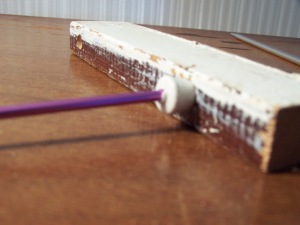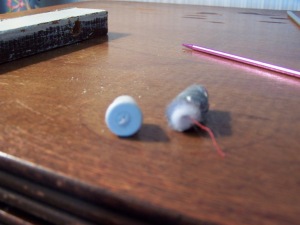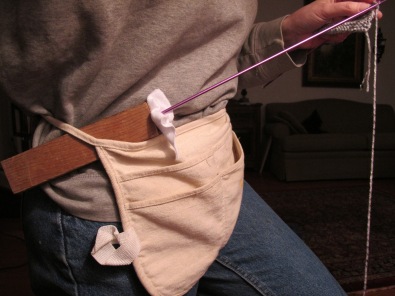Rudimentary Knitting Sheath Update
My original post describing a rudimentary knitting sheath must have gotten picked up by search engines, because it has recently become my most-read post and attracted readers from several different countries. (Hello, Canada, Australia, and U.K.!) After writing the first post, I got frustrated by wobble in the sheath-needle and tried to come up with a snugger fit to eliminate any motion.
The most obvious solution was to use needles without caps so that the part of the needle inserted into the sheath was the same diameter all the way down. This made the hole snug around the entire portion of the needle inserted into the block of wood. One can buy needles without caps, but I took a pair and cut the caps off with bolt cutters. This worked fine. When the needle is not in the sheath, I put a stitch counter on the end where the cap used to be to prevent the work from sliding off when I set it down.
I didn’t want to cut the caps off of all my needles, though, and I sure didn’t want to replace them all with capless needles. The needle needs to be inserted about half an inch into the sheath to hold it steady. So I needed to figure out how to fill in the space in a more stable way than stuffing batting in the hole. One way was to wrap the end of the needle tightly with batting then hold it in place with duct tape. Surprisingly, when the wrapping is tight, this holds the needle firmly. I haven’t used it much so I’m not sure how long the batting will hold up, but it is cheap and easy.
The second way was to take a plastic cap that fits into the hole and poke a hole in the center. I used the knitting needle I would be using the cap with to poke the hole, so the hole was the perfect size. This method holds the needle very firmly – there is no motion at all. The caps I used came off of the ends of an old café style curtain rod.
I find that I knit quicker with less wobble in the needle stuck in the sheath. I opted for low tech, inexpensive solutions to the wobble. Other possibilities I thought of but didn’t try were wooden beads and a stack of small washers. Because there seems to be a fair amount of interest in making one’s own sheath, I wanted to share this update.
Happy knitting!



